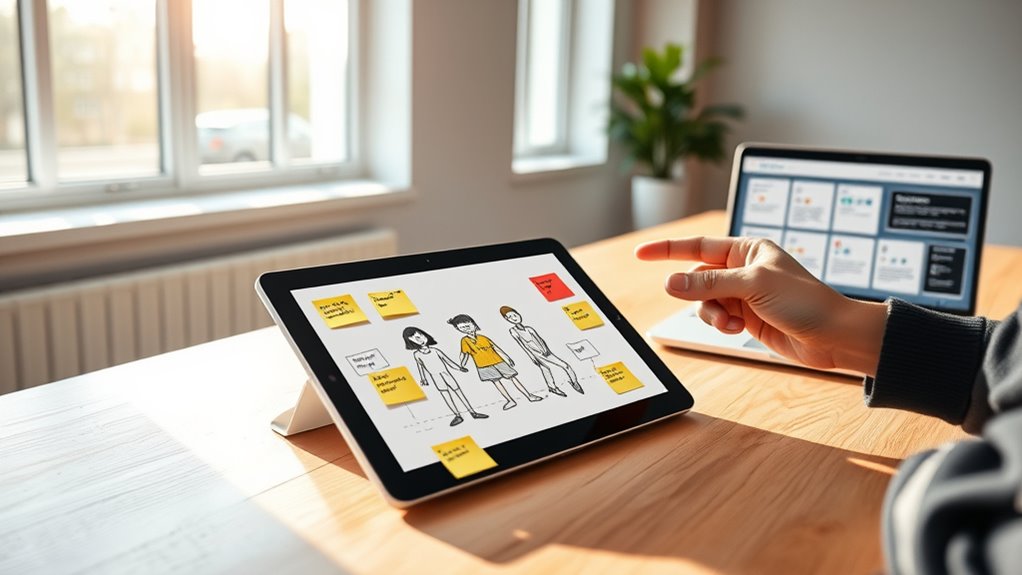When time is tight, creating proto-personas helps you quickly focus on key user traits like motivations and frustrations without extensive research. Focus on observable behaviors, basic demographics, and team insights to develop simple profiles that guide your design and decision-making. Use templates or visual tools to accelerate this process, and embed these proto-personas into your workflow for ongoing updates. Keep it straightforward—if you keep an open mind, you’ll discover practical ways to stay user-focused when it matters most.
Key Takeaways
- Use simplified, assumption-based profiles to quickly identify core user segments and guide early design decisions.
- Leverage pre-designed templates and visual tools for rapid persona creation and team alignment.
- Focus on essential traits, motivations, and frustrations to prioritize features without extensive research.
- Incorporate insights from existing feedback and analytics to make personas relevant and actionable.
- Regularly update proto-personas through team collaboration to maintain direction amid tight timelines.
Understanding the Concept of Proto-Personas

Understanding proto-personas begins with recognizing that they are simplified, early-stage representations of your target users. These sketches focus on key traits that influence user experience, helping you quickly grasp who your users are and what they need. Proto-personas aren’t based on extensive research; instead, they rely on assumptions, initial market segmentation, and team insights. This makes them ideal for fast-paced projects where time is limited. By creating these rough profiles, you can align your team’s understanding, prioritize features, and make informed decisions without waiting for detailed data. Incorporating natural elements and soft color palettes can further enhance your team’s understanding of user preferences and environments. Ultimately, proto-personas serve as a practical starting point, guiding your early design and development efforts while keeping your focus on delivering a user-centered experience.
Benefits of Using Proto-Personas in Fast-Paced Environments

In fast-paced environments where time is limited, proto-personas offer a practical way to quickly align your team and make informed decisions. They streamline user research by focusing on key assumptions, saving time while still capturing essential user needs. This rapid approach helps you identify core user segments early, reducing guesswork. Proto-personas also improve stakeholder alignment by providing a shared understanding of user priorities, even with minimal data. They foster collaboration and ensure everyone’s on the same page, enabling quicker iterations and adjustments. By using proto-personas, you avoid lengthy research processes without sacrificing direction. This approach keeps your project moving forward efficiently, ensuring your team stays focused on what truly matters for your users and business goals. Additionally, understanding key traits of successful quality assurance engineers can help in building a team that effectively supports this rapid development process.
Key Differences Between Proto-Personas and Full Personas

You’ll notice that proto-personas offer less detailed insights compared to full personas, making them quicker to create but less exhaustive. They focus on broad assumptions rather than deep understanding, which can impact the accuracy of your user representation. Development of full personas involves more effort but provides richer data, leading to better-informed decisions. Additionally, understanding the potential pitfalls in adopting new payment technologies can help tailor more effective user profiles.
Depth of Insight
While proto-personas typically offer a surface-level view of potential users, full personas dive much deeper into their motivations, behaviors, and needs. The key difference lies in the depth of insight you gain. Full personas explore emotional depth, revealing what truly drives user decisions and feelings. They also account for cultural nuances, helping you understand how background and context influence user behavior. This richer understanding allows you to design more tailored solutions that resonate on a personal level. Proto-personas, by contrast, provide a quick snapshot, often missing these subtle but impactful details. If you need to develop a user-centered approach quickly, proto-personas give you direction, but for exhaustive insights, full personas uncover the underlying layers of user experience. Additionally, understanding juice detox side effects and benefits can inform more empathetic and practical user personas for health-related products or services.
Development Complexity
Developing full personas requires a significant investment of time, resources, and research effort, making them inherently more intricate than proto-personas. This complexity impacts your ability to quickly adapt and iterate on user experience strategies. Full personas incorporate detailed demographics, motivations, and behaviors, which demand exhaustive data collection and analysis. As a result, they can enhance user engagement by providing deeper insights into your audience, but they also slow down decision-making processes. In contrast, proto-personas focus on essential characteristics, allowing you to sketch user types rapidly. This streamlined approach reduces development complexity and accelerates project timelines, enabling you to test ideas and adapt your user experience more swiftly without sacrificing critical user understanding. Additionally, understanding projector technology can help tailor experiences to meet user needs more effectively.
Steps to Create Effective Proto-Personas Quickly

Creating effective proto-personas quickly requires focusing on essential user insights and leveraging readily available data. Start by gathering basic information from existing sources like customer feedback, website analytics, and support tickets. Identify common user needs and pain points that emerge across these data points. Next, sketch out quick profiles based on observable customer behaviors, such as purchasing patterns or service interactions. Keep these personas simple—highlight key motivations, frustrations, and goals. Avoid overcomplicating details; the goal is to capture enough context to inform your design or strategy swiftly. Engage your team for rapid input to refine these insights. By concentrating on core user needs and customer behaviors, you create practical proto-personas that provide immediate guidance without lengthy research. Incorporating mindfulness techniques can also help teams maintain focus and clarity during this condensed process.
Tools and Templates to Accelerate Proto-Persona Development

Using the right tools and templates can considerably speed up your proto-persona development process. Persona mapping templates streamline organizing key insights, helping you quickly identify patterns and common traits among users. These templates often include sections for demographics, behaviors, motivations, and pain points, making user segmentation more straightforward. Digital tools like Miro, Figma, or Airtable offer visual and collaborative features that facilitate rapid idea sharing and iteration. Pre-designed templates save time by providing a structured starting point, ensuring you capture essential details without reinventing the wheel. Additionally, understanding sticking wall decor techniques can inspire creative ways to visualize user personas in team spaces. By leveraging these resources, you can efficiently create proto-personas that guide your design and development efforts, even when time is tight.
Integrating Proto-Personas Into Your Workflow

Integrating proto-personas into your workflow guarantees they become a practical part of your project rather than just a separate task. To do this, share them with your team early and often, encouraging collaboration and feedback. Use these personas to guide discussions on user engagement strategies and feature prioritization, ensuring everyone aligns around a common user understanding. Incorporate proto-personas into your existing tools, like project management or design frameworks, so they naturally influence decisions. Regularly revisit and update them as new insights emerge, making them dynamic tools for team collaboration. Additionally, leveraging aesthetic home decor ideas can provide creative inspiration for designing user interfaces that resonate with your target audience. By embedding proto-personas into your daily routines, you ensure they inform your work consistently, helping your team stay user-focused even under tight deadlines.
Common Mistakes to Avoid When Building Proto-Personas

One common mistake to avoid when building proto-personas is relying too heavily on assumptions rather than data. Assumption pitfalls can lead you to create personas based on stereotypes or guesswork, increasing bias risks and misaligning your team’s understanding of your users. It’s tempting to fill gaps quickly, but skipping validation can reinforce false beliefs. Be cautious of confirmation bias, where you unconsciously seek information that supports your preconceptions. To prevent this, focus on gathering quick, relevant insights from existing data, customer feedback, or team observations. Keep your proto-personas flexible and avoid rigid stereotypes. Remember, the goal is to guide your project effectively, not to solidify biased notions. Being aware of these common mistakes ensures your proto-personas remain useful and aligned with real user needs. Additionally, understanding best heat pump features can provide valuable insights into user preferences for energy efficiency and comfort, helping shape more accurate user profiles.
Case Studies: Successful Applications of Proto-Personas

Case studies demonstrate how proto-personas can effectively guide product development and marketing strategies, even in the early stages of project planning. In these examples, teams used simple customer segmentation to identify key user archetypes, allowing them to understand core needs and motivations without extensive research. For instance, a startup developed proto-personas based on basic demographic data and anecdotal insights, which helped prioritize features aligned with user priorities. Another case involved a marketing campaign that targeted early adopters with specific behaviors, using proto-personas to craft personalized messaging. These studies show that even rough archetypes can streamline decision-making, align teams, and reduce uncertainty. By focusing on core traits, you can quickly adapt your strategies and create products that resonate with your target audience from the outset. Additionally, employing best practices for creating effective proto-personas ensures they remain relevant and actionable throughout the project lifecycle.
Tips for Evolving Proto-Personas Over Time

As your product or project develops, continually refining your proto-personas guarantees they stay relevant and useful. Regular user research helps uncover new insights about your target audience, ensuring your personas reflect current behaviors and needs. Engage stakeholders often to maintain alignment; their input ensures everyone understands and supports evolving personas. Update proto-personas after key milestones or user feedback sessions to incorporate fresh data. Avoid static assumptions by reviewing and adjusting personas periodically, especially when market conditions change. Document changes transparently so your team remains aligned. Remember, evolving proto-personas isn’t a one-time task—it’s an ongoing process that keeps your product user-focused and strategically aligned. This continual refinement maximizes the value of your proto-personas over time.
Frequently Asked Questions
How Do Proto-Personas Differ Across Various Industries?
When exploring how proto-personas differ across industries, you notice that industry-specific adaptation is key. You tailor proto-personas based on unique customer behaviors and needs for each sector. Cultural considerations also play a role, influencing how you interpret user motivations and preferences. By adjusting these factors, you create relevant, targeted insights quickly, even when time is tight, helping guide your product development and marketing strategies effectively across diverse industries.
Can Proto-Personas Replace Full Personas in All Projects?
Think of proto-personas as quick sketches instead of full portraits. They offer rapid insights but lack the depth of detailed personas. While proto-personas can guide early stages and foster stakeholder alignment, they can’t replace full personas for thorough understanding or long-term strategy. Relying solely on proto-personas risks stalling persona evolution, so use them as a starting point, not the final destination in your user research.
What Are Common Challenges When Creating Proto-Personas Quickly?
When creating proto-personas quickly, you often face time constraints that limit thorough research and data collection. Stakeholder alignment can also be challenging, as everyone may have different assumptions or priorities. To overcome these issues, focus on rapid, collaborative workshops and use existing knowledge or assumptions to sketch out key user segments. Keep it flexible and update your proto-personas as new insights emerge, ensuring they remain useful despite tight timelines.
How Often Should Proto-Personas Be Updated in Rapid Cycles?
It’s funny how often you think your proto-personas are set in stone, yet they should be refreshed with regularity. You’ll want to balance speed with accuracy, so updating every few weeks allows for ongoing persona validation and stakeholder feedback. This keeps your personas relevant without draining resources. Staying agile ensures your team remains aligned and responsive, proving that frequent updates aren’t just necessary—they’re essential for meaningful progress.
Are There Specific Roles Best Suited for Proto-Persona Development?
You should focus proto-persona development on roles that drive stakeholder alignment and team collaboration, such as product managers, UX designers, and marketers. These roles directly influence project direction and customer understanding, making them ideal for creating quick, effective proto-personas. By involving these key team members, you guarantee everyone stays aligned, fosters collaboration, and accelerates decision-making, even when time is tight.
Conclusion
Think of proto-personas as your quick-lit map in uncharted territory—guiding your journey when time’s scarce. They’re your compass, steering you through the fog of uncertainty with just enough clarity to keep you moving forward. Embrace these swift sketches, refine them as you go, and watch your project flow smoothly like a river cutting through mountain terrain. With proto-personas, you’re always on course, even when the clock’s ticking loud.









